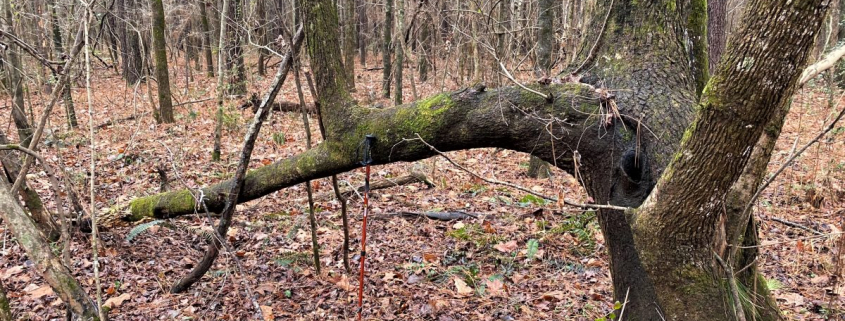Indian Marker Trees: Separating Folklore from Fact
January 22, 2021, I revisited the bottomland hardwood forests on the eastern end of the nearby Wheeler National Wildlife Refuge. I bushwhack this area at least monthly, especially during the dormant season, when understory vegetation is leafless, briars are easier to avoid, mushrooms are more visible, sweating must be earned, and redbugs, ticks, and biting insects are absent. Sure, saturated soils and some standing water (see below right) often re-route my passage, but waterproof boots handle all but the swampiest locales.
I decided in advance that on this visit, in addition to remaining alert for edible mushrooms, I would focus my attention and camera lens on Indian marker trees. The June 2017 online Treehugger:
If you’ve ever encountered a bent tree while hiking in North American woods, you may have simply happened upon a tree that was bowed by weather, disease or other natural causes. However, you might have stumbled upon an ancient trail marker created by Native Americans hundreds of years ago. Known as trail trees, these markers were used to designate trails, crossing points on streams, medicinal sites to find plants, and areas of significance like council circles.
The online Trail Tree Project offers additional insight:
Hiking along the crest of our mountain ridge in North Georgia, one has little question that the bent trees along the path are the living relics of a lost civilization. Even a century and a half after the Cherokees were shipped west along the Trail of Tears, the shape of the trees themselves maintain the sharp angles that characterize human design rather than the gentle curves that nature carves with wind and climate – curves amply expressed in the neighboring trees. And, in this area, they seem to connect well known Cherokee tribal sites. But how can we know for sure? They’re not particularly huge trees to be centurions. Could their placement on the mountain crests roughly paralleling the path of the original Appalachian Trail have some simple physical explanation? How can we be certain that this isn’t just another romantic rural legend?
I offer this Post to shed some light on whether the tree form oddities and curiosities I encountered can be traced to Native American trail markings, memorials, or other physical demarcations of significant features. I’ve noticed that many of my trail-trekking acquaintances accept the romanticism of “seeing” Native American presence in our forests, embracing the palpable “evidence” of our present day connection to the Native populations forced to leave these lands for western reservations more than 150 years ago. Some see the two sweetgum trees below as interpretable messages left behind. There is no doubt that both trees point to something. I spent years managing industrial forestlands in the southeastern USA, where we achieved maximum timber value production on lands well-suited to intensive management (planting genetically improved stock, competition control, fertilization, and thinning). In gest, I often point out to colleagues that any two trees in our natural stands are arranged in a straight line. Of course they are — just as any leaning tree “points” to something.
The tree below right reminds me of a long-necked green-skinned reptile, head high above the photo frame, with its left foreleg (we can assume one on the other side as well) leading the creature toward the standing water ahead. Both trees at some point suffered a near-crushing blow from above, slamming the then-seedling/sapling to the ground. The left-frame individual sent two shoots (now twin main stems) from the point where the original smashed tree lost its top. The other bent severely, but was not damaged sufficiently to prevent it righting itself, straightening, and reaching toward the vertical again.
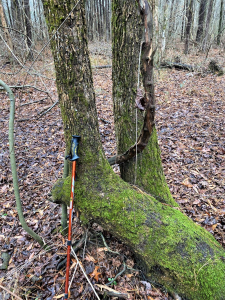
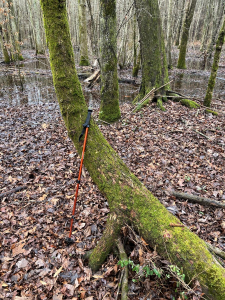
During my nine-year faculty and administrative tenure at Penn State University, I often conducted weekend forestry workshops for forest landowners, who almost invariably believed that Pennsylvania’s forests date back as far as “the time of Christ.” However, most of that state’s forests had been clearcut at least once by the mid-to-late Nineteenth Century. Original and old-growth stands are rare. Similarly, most of north Alabama’s forests had been harvested at least once by 1900… nearly a half a century since most Natives had been ushered west. The particular stand I hiked January 22, had been clearcut to prepare for flooding of Lake Wheeler once the TVA completed Wheeler Dam construction and began filling the impoundment. These bottomland hardwood forests occupy lands acquired with purchase of what is now submerged, serving as a TVA-owned buffer to the reservoir. No Native American has hunted or foraged in these forests since well before the TVA acquired and clearcut them. Every tree form oddity and curiosity I encountered originated from Nature acting unassisted by the hand of man.
Like the two individuals above, some force (falling branch, top, or tree) brought a younger version of the trees toward the horizontal. Both “recovered” by sending shoots vertically from the bent saplings. Were these the result of Native American handiwork, what message would you take from the convoluted branching below left? I just visited some of the Indian marker trees (or thong trees) web sites. I see images of larger trees that look just like the tree below left… trees old old enough, I suppose, to have been shaped by the work of Native Americans. Yet, I remind myself and readers that the forest I trekked is no more than 100 years old. In 1831, the U.S. government forced Native Americans to leave their homes in Georgia, Tennessee, and Alabama and relocate to Oklahoma, the procession westward becoming known as the Trail of Tears. We can deduce that any Native American-created marker trees would now be at least 190 years old.
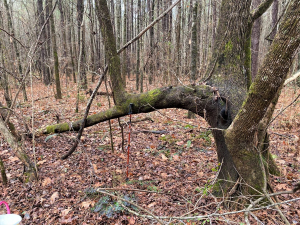
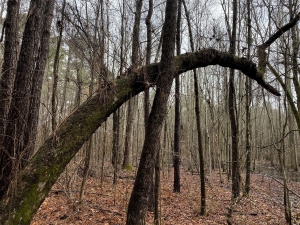
The area I hiked supports an even-aged forest naturally regenerated 70-90 years ago. The Native Americans that had roamed this land for 13,000 years, had already been forcibly relocated 100 years before all of the trees in these photos first reached for sunlight. Every tree form oddity and curiosity I encountered is the work of Nature, unassisted by human design, leather thongs, or purposed directional bending. I’ll repeat a 500-year-old Leonardo da Vinci quote that I use frequently in my speaking and writing:
Human subtlety will never devise an invention more beautiful, more simple or more direct than does nature because in her inventions nothing is lacking, and nothing is superfluous.
Please know that I am not debunking the notion that Native Americans had learned and applied a means of marking trails, springs, villages, burial grounds, and other such places and memorials of significance. I offer da Vinci’s observation only to remind us that those remarkable first Americans simply borrowed from Nature’s toolkit. Long before Native Americans crossed the Bering Land Bridge and ventured south and east into our state, trees and heavy branches had fallen onto other trees, bending, breaking, and laying them toward the horizontal. Through her inventions, Nature found ways to deal with those physical abuses. Recall the axiom: Necessity is the mother of invention. The driving imperative across Nature is to survive and reproduce, to ensure species (and individual) sustainability.
da Vinci also observed, Necessity is the mistress and guardian of Nature.
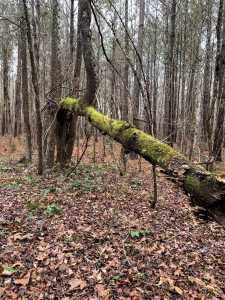
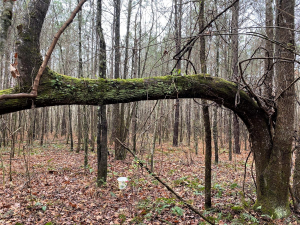
Every tree in this photo-series suffered physical damage… and survived, continuing to reach into the canopy and achieve seed-bearing age. Native Americans survived and thrived over 13 millennia by learning from Nature and living in harmony with her. I am certain that they learned from Nature how to create marker trees. This sweetgum (Liquidambar styraciflua), bent severely as a sapling, sent three sprouts vertically.
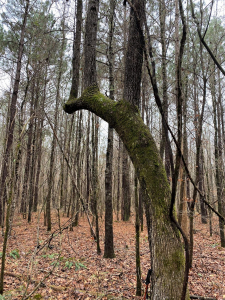
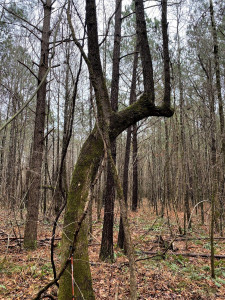
The two sweetgum trees below recovered from being slammed to the ground as a seedling/sapling, and sending sprouts vertically, now reaching into the intermediate canopy.
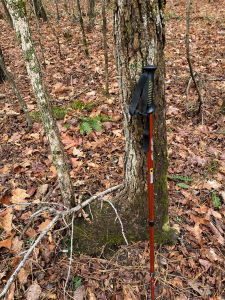
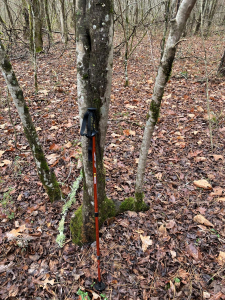
The pattern of battery and recovery repeats often and continuously. We’ve all heard the human wisdom, what doesn’t kill you, makes you stronger. I am not suggesting that these trees are stronger because the fates dropped a branch on them. Instead, Nature prepares for any eventuality.
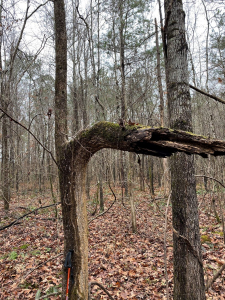
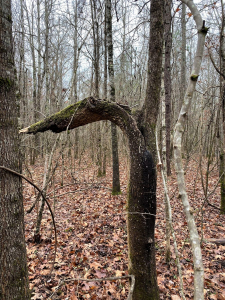
Our esteemed da Vinci did not miss much, observing that:
Nature is the source of all true knowledge. She has her own logic, her own laws, she has no effect without cause nor invention without necessity.
I won’t speculate on the injury and response mechanism that shaped the two forms below. Nor did da Vinci, knowing the infinite range of possibilities within Nature, try to imagine and catalog all possibilities:
Nature is full of infinite causes that have never occurred in experience.
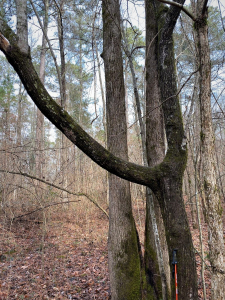
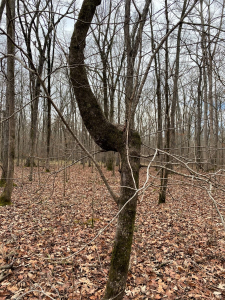
More than two centuries ago, English poet William Cowper observed, Variety’s the very spice of life, that gives it all its flavour. I found a forest of rich variety as I roamed the January bottomland forest.
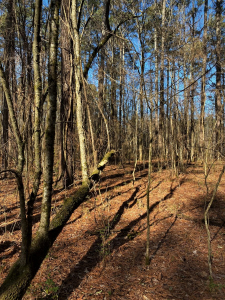
I’ve travelled through time for nearly 70 years (at a constant pace of 60-minutes-per-hour) and made 13 interstate moves. We have friends who have across those seven decades resided in the same town where we graduated high school. They have lived deep; Judy and I have lived wide. I’ve now visited this bottomland hardwood forest a dozen times. My understanding is deepening. Each visit opens my eyes to the incredible richness of variety:
- Hour by hour
- Day to day
- Season to season
- Tree by tree
- Stand by stand
Nothing in Nature is static. With his timeless wisdom, da Vinci noted, Nature never breaks her own laws. Whether instigated by a falling branch or guided by the hand of man securing a rawhide binding, Nature follows her own laws. She worries not of the cause (man or gravity-induced fate), but simply applies her wisdom to secure species/individual sustainability.
Thoughts and Reflections
I offer three observations from my late November trek through the bottomland forest:
- Everything in Nature occurs in accord with her own immutable laws
- Folklore and fancy often reach beyond reality
- Yet, woods-lore enriches our appreciation of Wildness
Inhale and absorb Nature’s elixir. May Nature Inspire, Inform, and Reward you!
Note: All blog post images created & photographed by Stephen B. Jones unless otherwise noted. Please circulate images with photo credit: “©2021 Steve Jones, Great Blue Heron LLC. All Rights Reserved.”
Another Note: If you came to this post via a Facebook posting or by an another route, please sign up now (no cost… no obligation) to receive my Blog Post email alerts: http://eepurl.com/cKLJdL
And a Third: I am available for Nature-Inspired Speaking, Writing, and Consulting — contact me at steve.jones.0524@gmail.com
Reminder of my Personal and Professional Purpose, Passion, and Cause
If only more of us viewed our precious environment through the filters I employ. If only my mission and vision could be multiplied untold orders of magnitude:
Mission: Employ writing and speaking to educate, inspire, and enable readers and listeners to understand, appreciate, and enjoy Nature… and accept and practice Earth Stewardship.
Vision:
- People of all ages will pay greater attention to and engage more regularly with Nature… and will accept and practice informed and responsible Earth Stewardship.
- They will see their relationship to our natural world with new eyes… and will understand more clearly their Earth home.
Tagline/Motto: Steve (Great Blue Heron) encourages and seeks a better tomorrow through Nature-Inspired Living!
Steve’s Three Books
I wrote my books Nature Based Leadership (2016), Nature-Inspired Learning and Leading (2017), and Weaned Seals and Snowy Summits: Stories of Passion for Place and Everyday Nature (2019; co-authored with Dr. Jennifer Wilhoit) to encourage all citizens to recognize and appreciate that every lesson for living, learning, serving, and leading is either written indelibly in or is powerfully inspired by Nature.
I began writing books and Posts for several reasons:
- I love hiking and exploring in Nature
- I see images I want to (and do) capture with my trusty iPhone camera
- I enjoy explaining those images — an educator at heart
- I don’t play golf!
- I actually do love writing — it’s the hobby I never needed when my career consumed me
- Judy suggested my writing is in large measure my legacy to our two kids, our five grand kids, and all the unborn generations beyond
- And finally, perhaps my books and Blogs could reach beyond family and touch a few other lives… sow some seeds for the future


All three of my books (Nature Based Leadership; Nature-Inspired Learning and Leading; Weaned Seals and Snowy Summits) present compilations of personal experiences expressing my (and co-author Dr. Wilhoit for Weaned Seals and Snowy Summits) deep passion for Nature. All three books offer observations and reflections on my relationship to the natural world… and the broader implications for society. Order any and all from your local indie bookstore, or find them on IndieBound or other online sources such as Amazon and LifeRich.

